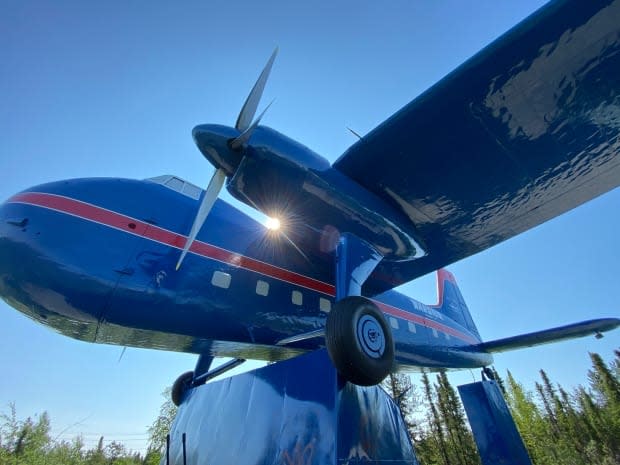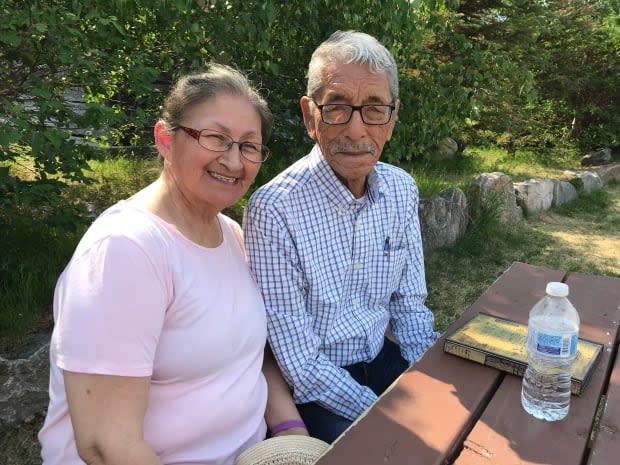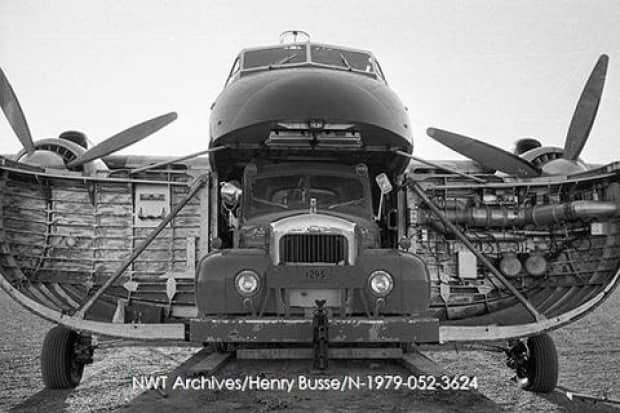Survivor's memories of plane trip to N.W.T. residential school points to aviation's role in the system

WARNING: This story contains distressing details.
Ernie Bernhardt remembers all too well the first time he went on an airplane.
In 1959, the residential school he was attending in the hamlet of Aklavik, N.W.T., had closed and he was being sent to Akaitcho Hall residential school in Yellowknife instead.
He was 15 years old when he boarded the Bristol 170 Freighter Mk31 operated by the Wardair airline.
"Your name was called and you hopped on the airplane," said Bernhardt. "I ended up sitting in the front by the left side motor. Holy smokes ... was it ever noisy, and kind of a cool airplane."

Today, the cargo aircraft sits at an entry point to Yellowknife as a monument to the role of aviation in opening up Canada's North. But for Bernhardt, the aircraft represents something far more ominous: the role of aviation in ferrying children to residential schools — some of whom would never return home.
There are few historical records documenting the role of the companies and planes in bringing Indigenous children to the schools, but people studying the aviation industry's involvement say they were an integral part of the system.
"Many residential schools, especially in the Arctic regions, could not have been open and operated without the use of airplanes to transport children," said Davide Montebruno, curator of the Royal Aviation Museum of Western Canada in Winnipeg. Indigenous researchers have been working with the museum to gather information on the aviation industry's involvement in the residential school system.
No happy faces
The plane was packed with students on that journey in 1959, recalls Bernhardt, a former member of the legislative assembly and former mayor of the hamlet of Kugluktuk in Nunavut.
"Most of the kids, they didn't have a happy face," he said. "They knew they were leaving home. You could cry but no one's going to hear you. The plane was too damn noisy."
Bernhardt himself recalls being frightened to leave Aklavik, which is the Inuvik Region of the Northwest Territories, without his siblings and the nun who had cared for him from the age of 10 months, after his mother died.
"I won't be able to see my sister. I won't be able to see my brother and I won't be able to see the nun that brought me up," he recalled thinking. "So, I boarded the plane and I cried quite a few miles."
Landing on the North Pole
Two years before Bernhardt made that journey, Canadian aviation pioneer Max Ward, who owned Wardair, had bought the Bristol 170 Freighter from Transair of Winnipeg for $300,000. According to Ward's biography, it was the only Bristol aircraft in his fleet until 1967.
The aircraft could carry six tonnes of cargo and load vehicles and heavy equipment for mining projects with its wide doors at the front of the nose.

It was built to carry cargo but could also carry up to 58 people, according to a 1975 transport department document.
Among its notable journeys, it brought the first fire truck to Yellowknife in 1957. It was among the first planes to open up access to the North and in 1967 became the first heavy wheeled aircraft to land on the North Pole.
An article in the News North newspaper in the territories from 1970 attests to its involvement in residential school transportation — referring to it as a school bus transporting children to and from schools in settlements.
Taken out of service in 1968, it was displayed as a symbol of the role of aviation in shaping the North.
Aviation's role 'not well known'
The Truth and Reconciliation Commission (TRC) examining residential schools has had difficulty obtaining official records of the flights carrying children to the residential schools, according to Montebruno.
In collaboration with Indigenous researchers, such as Anishinaabe Writer and University of Manitoba professor Dr. Niigaan Sinclair, the Royal Aviation Museum of Western Canada in Winnipeg is hoping to fill some gaps by gathering material and testimonials taken by the TRC to document — and display — aviation's role in the residential school system.
The museum's goal is to make the information, as well as stories from community members, publicly accessible to promote public education, Montebruno said.
"The kind of information we've been able to gather are first hand accounts of not just the students, not just the children who were taken from their homes, but also the pilots and in some cases flight attendants, stewardesses and other industry professionals," said Montebruno.
In a recent column written for the Winnipeg Free Press, Sinclair spoke about the significance of the project, noting, "In many Indigenous communities, the arrival of a plane signalled the imminent removal of children."
'Some monuments are good'
When Bernhardt drives by the Bristol monument he often slows down and thinks back to that plane ride.
"When I go by there I always look at that airplane," he said.
"I want to cry but I can't. It's sore, you know, leaving your own people behind. Going to someplace strange."
Bernhardt says he wants the monument to stay where it is and that it could be used to educate the public about residential school survivors.
"Some monuments are good," he said. "It's just a reminder of what was. Even if it might be a little bit bad. It could be learned as a history for people to study."
Support is available for anyone affected by their experience at residential schools, and those who are triggered by these reports.
A national Indian Residential School Crisis Line has been set up to provide support for residential school survivors and others affected. People can access emotional and crisis referral services by calling the 24-hour national crisis line: 1-866-925-4419.
The NWT Help Line offers free support to residents of the Northwest Territories, 24 hours a day, 7 days a week. It is 100% free and confidential. The NWT Help Line also has an option for follow-up calls. Residents can call the help line at 1-800-661-0844.
In Nunavut, the Kamatsiaqtut Help Line is open 24 hours a day at 1-800-265-3333. People are invited to call for any reason.
In Yukon, mental health services are available to those in both Whitehorse and in rural Yukon communities through Mental Wellness and Substance Use Services. Yukoners can schedule Rapid Access Counselling supports in Whitehorse and all MWSU community hubs by calling 1-867-456-3838.
Do you know of a child who never came home from residential school? Or someone who worked at one? We would like to hear from you. Email our Indigenous-led team investigating the impacts of residential schools at wherearethey@cbc.ca or call toll-free: 1-833-824-0800.

 Yahoo Movies
Yahoo Movies 